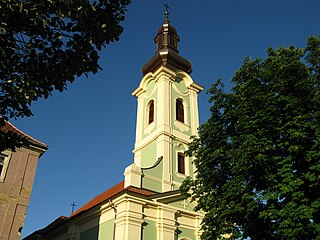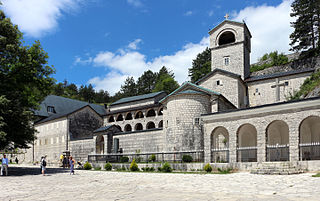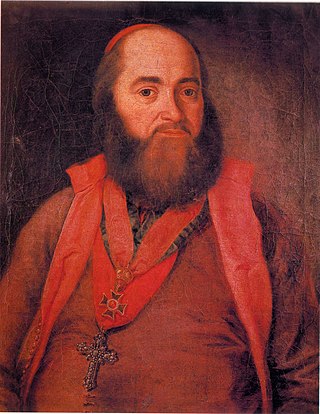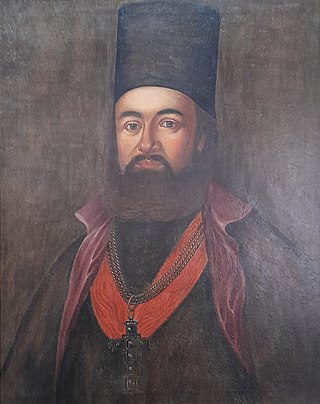
The Serbian Orthodox Church is one of the autocephalous Eastern Orthodox Christian churches.

The Eparchy of Gornji Karlovac is an eparchy of the Serbian Orthodox Church seated in the city of Karlovac, Croatia. It covers the area of Banovina, Kordun, Lika, Krbava, Gorski Kotar, as well as northern Croatia and Istria.

The Metropolitanate of Montenegro and the Littoral of the Serbian Orthodox Church is the largest eparchy (diocese) of the Serbian Orthodox Church in modern Montenegro. Founded in 1219 by Saint Sava, as the Eparchy of Zeta, it continued to exist, without interruption, up to the present time, and remained one of the most prominent dioceses of the Serbian Orthodox Church. The current Metropolitan bishop is Joanikije II. His official title is "Metropolitan of Montenegro and the Littoral".

The Eparchy of Srem is an eparchy (diocese) of the Serbian Orthodox Church in the Syrmia (Srem) region, Serbia. Most of the eparchy is in the autonomous province of Vojvodina, and it also includes a small south-eastern part of Syrmia within the city limits of Belgrade, as well as some West Syrmian parishes in the border region of Croatia. The seat of the eparchy is at Sremski Karlovci. Since 1986, the diocesan bishop is Vasilije Vadić.

The Eparchy of Banat is an ecclesiastical territory or eparchy of the Serbian Orthodox Church in the Banat region, Serbia. It is mostly situated in the autonomous province of Vojvodina, while the eparchy also includes a small south-western part of Banat that belongs to the City of Belgrade as well as village of Ostrovo that belongs to the city of Požarevac. The seat of the eparchy is in Vršac.

The Metropolitanate of Karlovci was a metropolitanate of the Eastern Orthodox Church that existed in the Habsburg monarchy between 1708 and 1848. Between 1708 and 1713, it was known as the Metropolitanate of Krušedol, and between 1713 and 1848, as the Metropolitanate of Karlovci. In 1848, it was elevated to the Patriarchate of Karlovci, which existed until 1920, when it was merged with the Metropolitanate of Belgrade and other Eastern Orthodox jurisdictions in the newly established Kingdom of Serbs, Croats and Slovenes to form the Serbian Orthodox Church.

The Metropolitanate of Belgrade was an Eastern Orthodox ecclesiastical province (metropolitanate) which existed between 1831 and 1920, with jurisdiction over the territory of Principality and Kingdom of Serbia. It was formed in 1831, when the Ecumenical Patriarchate of Constantinople granted church autonomy to its eparchies in the Principality of Serbia. Territorial enlargement and full canonical autocephaly were gained in 1879. The Metropolitanate of Belgrade existed until 1920, when it was merged with Patriarchate of Karlovci and other Serbian ecclesiastical provinces to form the united Serbian Orthodox Church. The seat of the Metropolitanate was in Belgrade, Serbia.

Arsenije III Crnojević was the Archbishop of Peć and Serbian Patriarch from 1674 to his death in 1706. In 1689, during the Habsburg-Ottoman War (1683–1699), he sided with Habsburgs, upon their temporary occupation of Serbia. In 1690, he left the Patriarchal Monastery of Peć and led the Great Migration of Serbs from Ottoman Serbia into the Habsburg monarchy. There he received three charters, granted to him by Emperor Leopold I, securing religious and ecclesiastical autonomy of Eastern Orthodoxy in the Habsburg Monarchy. In the meanwhile, after restoring their rule in Serbian lands, Ottomans allowed the appointment of a new Serbian Patriarch, Kalinik I (1691–1710), thus creating a jurisdictional division within the Serbian Orthodox Church. Until death, in 1706, Patriarch Arsenije remained the head of Serbian Orthodox Church in Habsburg lands, laying foundations for the creation of an autonomous ecclesiastical province, later known as the Metropolitanate of Karlovci.

The Kingdom of Serbia was a province (crownland) of the Habsburg monarchy from 1718 to 1739. It was formed from the territories to the south of the rivers Sava and Danube, corresponding to the Sanjak of Smederevo, conquered by the Habsburgs from the Ottoman Empire in 1717. It was abolished and returned to the Ottoman Empire in 1739.

The Karlovci Gymnasium is the high school (gymnasium) located in the town of Sremski Karlovci. It is the oldest secondary school in Serbia. This type of school is comparable to U.S. college preparatory schools or English grammar schools.

Mojsije Putnik (1728–1790) was the Metropolitan of Sremski Karlovci between 1781 and 1790, during the reign of Joseph II. He was known for publishing the Toleranzpatent meant to ensure equal rights for the Serbian Orthodox Church and the Catholic church in Sremski Karlovci.

Archbishopric of Belgrade and Karlovci is the central or patriarchal eparchy of the Serbian Orthodox Church, with seat in Belgrade, Serbia. The head of the eparchy is the Serbian patriarch.
Early modern history of Serbia refers to the history of Serbia during the Early Modern period, from the Ottoman conquest in the second half of 15th century up to the beginning of the Serbian Revolution in 1804. The era includes periods of Ottoman and Habsburg rule in various parts of Serbia. During that time, several Habsburg–Ottoman wars were fought on the territory of Serbia.
Mojsije I Rajović was the Archbishop of Peć and Serbian Patriarch, head of the Serbian Orthodox Church, from 1712 to 1725, with seat in the Patriarchal Monastery of Peć.
Vikentije Popović-Hadžilavić was metropolitan of the Serbiam Orthodox Metropolitanate of Karlovci, and the highest-ranking prelate of the Serbian Orthodox Church in the Habsburg Monarchy, from 1713 to 1725.

Isaija Đaković or Isaija I was elected to the rank of Metropolitan of Krušedol (Karlovci) in 1708. Isaija is best remembered as the first Serbian metropolite under Habsburg monarchy and for his diplomatic skills when he obtained the amendments in the Privileges. He was succeeded by Sofronije Podgoričanin.
Sofronije Podgoričanin was the Metropolitan of Krušedol, from 1710 to 1711, and one of the most important metropolitans of the Serbian Orthodox Church of the time. Sofronije succeeded metropolitan Isaija Đaković, who died in 1708.
Maxim Suvorov was the director of the printing house of the Russian Synod. He studied at the Slavic Greek Latin Academy.
The Serbian People's Church Council of Karlovac Metropolitanate represented the most important institutions of Serbs in the Habsburg monarchy.













